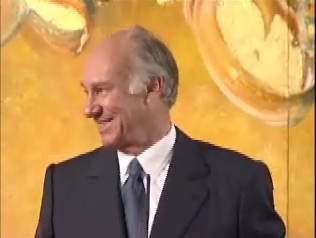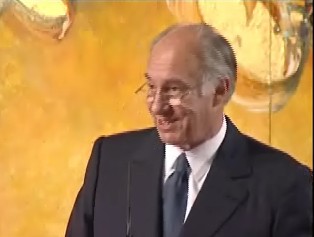
Aga Khan : ‘The Qur’an and its Creative Expressions’
His Highness the Aga Khan The Ismaili Centre, London October 19, 2003
Your Excellencies,
Your Worship,
Distinguished Scholars and Guests,
Ladies and Gentlemen,
An assembly of the wise and learned is a privileged occasion. I am, therefore, immensely happy to be with you this morning as you begin your deliberations on a theme which, though of perennial interest, holds a special significance at a time that calls for enlightened encounters among faiths and cultures. Whatever its vernacular forms, the language of art, more so when it is spiritually inspired, can be a positive barrier-transcending medium of discourse, manifesting the depths of the human spirit.
The venue for this international colloquium is particularly appropriate. In its architectural design and definition of broader functions, the Ismaili Centre in London, like its counterparts in other countries, has been conceived in a mood of dialogue, of humility, of friendship and of harmony. These Centres reflect a commitment to permeate excellence of endeavour in the realms of the intellect and the spirit.
I thank you most warmly for setting aside the time from your busy schedules to participate in this colloquium. I also congratulate the Institute of Ismaili Studies for marking the twenty-fifth year since its inauguration through this timely event. This is a part of its ongoing ambitious programme of Qur’anic studies in which scholars from around the world, both Muslim and of other persuasions, are participating. They bring to bear a variety of academic disciplines on a reflection of how Islam’s revelation, with its challenge to man’s innate gift of quest and reason, became a powerful impetus for a new flowering of human civilisation.
This programme is also an opportunity for achieving insights into how the discourse of the Qur’an-e-Sharif, rich in parable and allegory, metaphor and symbol, has been an inexhaustible well-spring of inspiration, lending itself to a wide spectrum of interpretations. This freedom of interpretation is a generosity which the Qur’an confers upon all believers, uniting them in the conviction that All-Merciful Allah will forgive them if they err in their sincere attempts to understand His word. Happily, as a result, the Holy Book continues to guide and illuminate the thought and conduct of Muslims belonging to different communities of interpretation and spiritual affiliation, from century to century, in diverse cultural environments. The Noble Qur’an extends its principle of pluralism also to adherents of other faiths. It affirms that each has a direction and path to which they turn so that all should strive for good works, in the belief that, wheresoever they may be, Allah will bring them together.
 Tradition honours the vocation of the learned scholars who are gathered here for this colloquium. The Qur’an itself acknowledges that people upon whom wisdom has been bestowed are the recipients of abundant good; they are the exalted ones. Hence Islam’s consistent encouragement to Muslim men and women to seek knowledge wherever it is to be found. We are all familiar that al-Kindi, even in the 9th century, saw no shame in acknowledging and assimilating the truth, whatever its source. He argued that truth never abases, but only ennobles its seeker. Poetising the Prophet’s teaching, Nasir Khusraw, the 11th century Iranian poet-philosopher, also extols the virtue of knowledge. For him, true jihad is the war that must be waged against the perpetrators of bigotry, through spreading knowledge that dispels the darkness of ignorance and nourishes the seed of peace that is innately embedded in the human soul.
Tradition honours the vocation of the learned scholars who are gathered here for this colloquium. The Qur’an itself acknowledges that people upon whom wisdom has been bestowed are the recipients of abundant good; they are the exalted ones. Hence Islam’s consistent encouragement to Muslim men and women to seek knowledge wherever it is to be found. We are all familiar that al-Kindi, even in the 9th century, saw no shame in acknowledging and assimilating the truth, whatever its source. He argued that truth never abases, but only ennobles its seeker. Poetising the Prophet’s teaching, Nasir Khusraw, the 11th century Iranian poet-philosopher, also extols the virtue of knowledge. For him, true jihad is the war that must be waged against the perpetrators of bigotry, through spreading knowledge that dispels the darkness of ignorance and nourishes the seed of peace that is innately embedded in the human soul.
This colloquium covers a range of Muslim expressions in the Arts, across time and space. Some among the eminent scholars present today have observed that, while the Qur’an may not propound a doctrine of Islamic art or material culture, it does offer imaginative scope in this direction. From early on, its passages have inspired works of art and architecture, and shaped attitudes and norms that have guided the development of Muslim artistic traditions.
In this context, would it not also be relevant to consider how, above all, it has been the Qur’anic notion of the universe as an expression of Allah’s will and creation that has inspired, in diverse Muslim communities, generations of artists, scientists and philosophers? Scientific pursuits, philosophic inquiry and artistic endeavour are all seen as the response of the faithful to the recurring call of the Qur’an to ponder the creation as a way to understand Allah’s benevolent majesty. As Sura al-Baqara proclaims: ‘Wherever you turn, there is the face of Allah’.
Does not the Qur’an challenge the artist, as much as the mystic, to go beyond the physical – the outward – so as to seek to unveil that which lies at the centre but gives life to the periphery? Is not a great work of art, like the ecstasy of the mystic, a gesture of the spirit, a stirring of the soul that comes from the attempt to experience a glimpse of, and an intimacy with, that which is ineffable and beyond being?
The famous verse of ‘light’ in the Qur’an, the Ayat al-Nur, whose first line is rendered here in the mural behind me, inspires among Muslims a reflection on the sacred, the transcendent. It hints at a cosmos full of signs and symbols that evoke the perfection of Allah’s creation and mercy. Many other verses of the Qur’an have similarly inspired calligraphy in all its forms, reminding us of the richness and vitality of Muslim traditions in the Arts.
 It is my sincere hope that this colloquium will bring additional insights to an understanding of the Holy Qur’an as a message that encompasses the entirety of human existence and effort. It is concerned with the salvation of the soul, but commensurately also with the ethical imperatives which sustain an equitable social order. The Qur’an’s is an inclusive vision of society that gives primacy to nobility of conduct. It speaks of differences of language and colour as a divine sign of mercy and a portent for people of knowledge to reflect upon.
It is my sincere hope that this colloquium will bring additional insights to an understanding of the Holy Qur’an as a message that encompasses the entirety of human existence and effort. It is concerned with the salvation of the soul, but commensurately also with the ethical imperatives which sustain an equitable social order. The Qur’an’s is an inclusive vision of society that gives primacy to nobility of conduct. It speaks of differences of language and colour as a divine sign of mercy and a portent for people of knowledge to reflect upon.
Ours is a time when knowledge and information are expanding at an accelerating and, perhaps, unsettling pace. There exists, therefore, an unprecedented capacity for improving the human condition. And yet, ills such as abject poverty and ignorance, and the conflicts these breed, continue to afflict the world. The Qur’an addresses this challenge eloquently. The power of its message is reflected in its gracious disposition to differences of interpretation; its respect for other faiths and societies; its affirmation of the primacy of the intellect; its insistence that knowledge is worthy when it is used to serve Allah’s creation; and, above all, its emphasis on our common humanity.
As this colloquium embarks on its deliberations, I wish you well in all your proceedings.
Thank you.
Source: The Institute of Ismaili Studies

Click on link below to play video of above speech

![]() Islamic Architecture Speeches by Mowlana Hazar Imam
Islamic Architecture Speeches by Mowlana Hazar Imam
![]() His Highness the Aga Khan’s Address at the 25th Anniversary Graduation Ceremony of the Institute of Ismaili Studies October 20, 2003
His Highness the Aga Khan’s Address at the 25th Anniversary Graduation Ceremony of the Institute of Ismaili Studies October 20, 2003
![]() His Highness the Aga Khan’s Speech at the Institute of Ismaili Studies 25th Anniversary Colloquium October 19, 2003
His Highness the Aga Khan’s Speech at the Institute of Ismaili Studies 25th Anniversary Colloquium October 19, 2003
![]() Mowlana Hazar Imam Interviewed By PRANAY GUPTE
Mowlana Hazar Imam Interviewed By PRANAY GUPTE
- Aga Khan stresses importance of pluralism — Ogden Lecture at Brown University
- Aga Khan Delivers Ogden Lecture at Brown University
- Pluralism and the Quran by Reza Shah-Kazemi
- Understanding the Quran — Diana Steigerwald
- Quran Collection on the Ismaili Web
- Imam Hazrat Ali and the Quran — Reza Shah-Kazemi
- Social Responsibility as Explained in the Quran — Ali Asani
- The Holy Quran in the Ginanic Literature – Rashida Noormohamed-Hunzai
- His Highness the Aga Khan’s Speech ‘Word of God, Art of Man: The Quran and its Creative Expressions’
- Selected Suras of the Quran
- Verses on Imamat in the Quran
- Women in the Quran
- Quran with Transliteration, Several Translations and Arabic Images
- Search the Quran
Pingback: Pluralism and the Qur’an – Reza Shah-Kazemi | Ismaili Web Amaana
Pingback: Importance of Imam Ali for All Muslims – Reza Shah Kazemi | Ismaili Web Amaana